In Philadelphia’s Museum of Art there hangs one of my favorites. Henry Osawa Tanner painted this image of the surprising encounter Mary had with the angel Gabriel. This visitor to her chamber, rendered as ineffable light, is speaking. He is announcing the Messiah’s entrance into matter. Of all the attempts to visualize this wonder, this to me is the best. Mary looks as she certainly was: frightened, young, simple and Semitic. She was no blond Italian (in Renaissance finery) blandly receiving such news. Such news. People still think it impossible. Tanner did not.
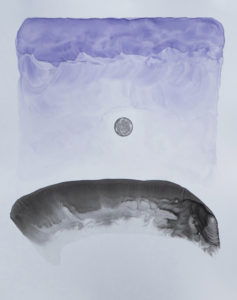
My Incarnation is the third in a present series (shown until September ’14 at the Reece Museum, ETSU). My rendering is meant to look as moonlight over part of the circumference. The hues are not dramatic, and not surreal. Light is reflecting quietly over matter, like a very purposed hovering over chaos.
But look more closely. A detail of the moon face shows the entrance of life in seed form. Soon a crowd of angels would break their silence when this baby would arrive full term. But even that arrival was surprising, only a few even “got it.” His own Mother, who witnessed it all would treasure up all these things, pondering them in her heart.
It all began here, tangibly speaking that is. In time, in a certain fragile space, the One who “is before all things, and in whom all things hold together” reduced Himself to the same dust we are made of so that He could justly win for us the only way out of this ground of dust. He came “all in” to both life and death as we experience it. And He purchased the way into the Life our hearts somehow know to yearn for. We are more than dust, because He became dust for us.
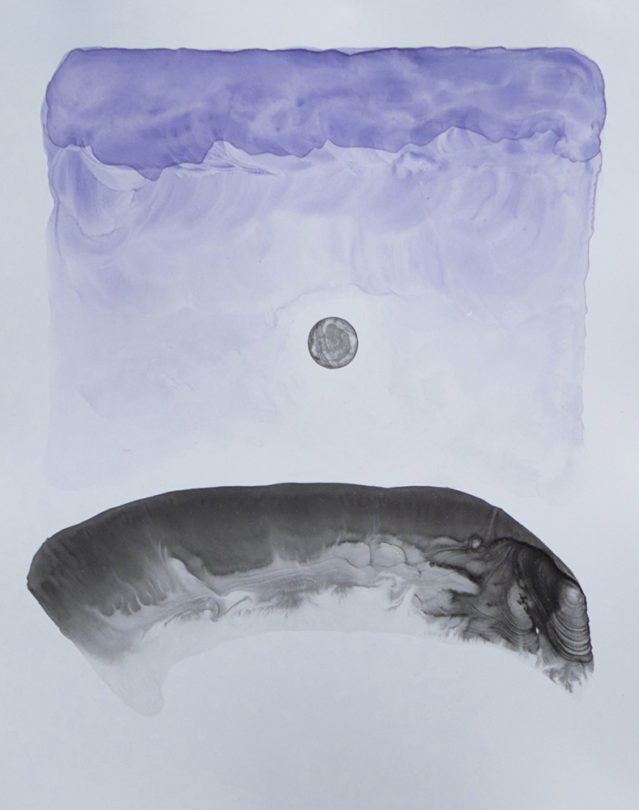
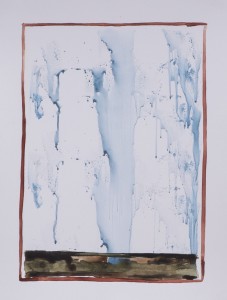 The first image, that of evil, called Abaddon, is dominant and encroaching, seemingly boundless and fearful. The second image is much quieter, gentle but life-giving, boundaried but free. It penetrates the ground rather than taking it over. And it is rimmed by this mysteriously fragile red enclosure. When I made this second image it was after studying some illuminated manuscripts from a book a friend had given me. The first image, as I wrote earlier, took over when I made it, surprised me, troubled me. But it seemed necessary to consider. This second image was planned more carefully, but its making also involved some serendipity. I used a brayer to lay down the veils of blue watercolor, loving the delicate surprise in the markings that resulted, and that were still “in character” with the quiet beauty of good.
The first image, that of evil, called Abaddon, is dominant and encroaching, seemingly boundless and fearful. The second image is much quieter, gentle but life-giving, boundaried but free. It penetrates the ground rather than taking it over. And it is rimmed by this mysteriously fragile red enclosure. When I made this second image it was after studying some illuminated manuscripts from a book a friend had given me. The first image, as I wrote earlier, took over when I made it, surprised me, troubled me. But it seemed necessary to consider. This second image was planned more carefully, but its making also involved some serendipity. I used a brayer to lay down the veils of blue watercolor, loving the delicate surprise in the markings that resulted, and that were still “in character” with the quiet beauty of good.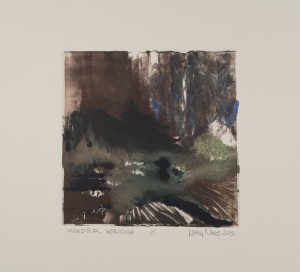

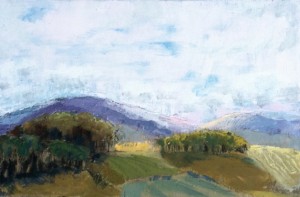 I have been enchanted by the big overlook for a long, long time; am coming to see reasons why in ways that are deeply satisfying and spiritually stretching. I remember a lecture I heard over 40 years ago about the Hebrew prophet Isaiah. He was a visionary who was given vistas to verbalize that were greater than he felt he could capture. He was a big picture guy. His words skip over the peaks of time, they run ahead, then linger back with comfort, and other times with terrible disruption. Time conflates in Isaiah’s visions. Assurances are way, way beyond him but he sees it! He scribes what he is given with his own unique voice.
I have been enchanted by the big overlook for a long, long time; am coming to see reasons why in ways that are deeply satisfying and spiritually stretching. I remember a lecture I heard over 40 years ago about the Hebrew prophet Isaiah. He was a visionary who was given vistas to verbalize that were greater than he felt he could capture. He was a big picture guy. His words skip over the peaks of time, they run ahead, then linger back with comfort, and other times with terrible disruption. Time conflates in Isaiah’s visions. Assurances are way, way beyond him but he sees it! He scribes what he is given with his own unique voice. Think about it, your body is a very dark place on its own. When scopes go into our bodies they must bring their own light, like miner’s lamps, to be able to see anything. When bodies are on surgical tables they are dark chasms until the surgeon’s knife cuts open flesh and the huge lights over the table light up what was hidden and all closed in. We only see these things because our eyes have taken in light first. This is simply true, and the physical is a signal/type for what is more important, the spiritual. Looking into someone’s eyes is often so intuitively instructive as to whether there is any life or light in there. According to Jesus, for any light to be inside us, we have to let it in, we have to allow our lamps to be lit. We cannot come forth with light on our own. Light was the 1st creative accomplishment in Genesis and it comes forth from God. This is basic though I stumble over it.
Think about it, your body is a very dark place on its own. When scopes go into our bodies they must bring their own light, like miner’s lamps, to be able to see anything. When bodies are on surgical tables they are dark chasms until the surgeon’s knife cuts open flesh and the huge lights over the table light up what was hidden and all closed in. We only see these things because our eyes have taken in light first. This is simply true, and the physical is a signal/type for what is more important, the spiritual. Looking into someone’s eyes is often so intuitively instructive as to whether there is any life or light in there. According to Jesus, for any light to be inside us, we have to let it in, we have to allow our lamps to be lit. We cannot come forth with light on our own. Light was the 1st creative accomplishment in Genesis and it comes forth from God. This is basic though I stumble over it.